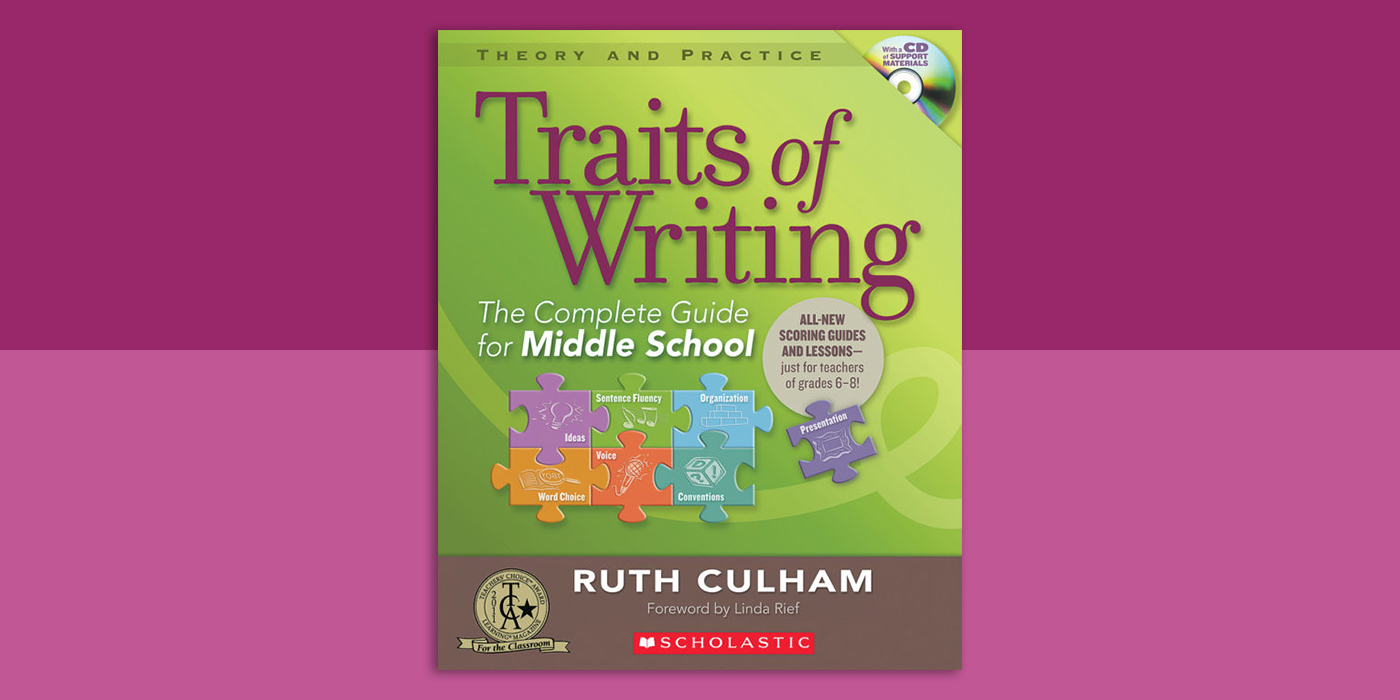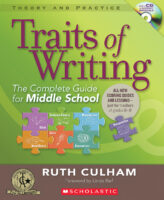Traits of Writing: The Complete Guide for Middle School
Mentor Texts, Model Lessons, and More to Teach Writing With the 6 Traits
By Ruth Culham
5 Secrets for Helping Middle School Writers Succeed
Even though I spent 19 years as a middle school teacher, I frequently ask myself what makes a middle school writing classroom work. I know successful teaching is a series of flexible moving parts. I know it’s one part inspiration and a bigger part organization. I know that every middle school teacher struggles to achieve more good days than bad.
In Traits of Writing: The Complete Guide for Middle School, I share meaningful and practical ideas for using what I’ve learned about teaching writing in middle school. My aim is to validate what you already know and give you new ways to support students. I also point out obstacles to watch out for and ways around them, so you don’t sacrifice the integrity of your teaching or the writing lives of your students.
As teachers, our greatest challenge may not be understanding best practices, but implementing those practices in classrooms where writing skills vary, time is precious, and the demand for high test scores can smother even the most creative teaching. But take heart. Teaching writing well is not impossible. Here are 5 secrets I know work in middle school and will help your young writers succeed:
1. The teacher must model how to learn.
If we want our students to write, we have to show them we are writers ourselves, which means opening ourselves up to scrutiny.
2. Learning should be infectious.
Look for inspiration everywhere and revise you lesson plans accordingly to foster a fascination with language, not just an understanding of terms. Who knows where this might lead?
3. Students must be active.
Engaging in lively activities, working in small groups, sitting on the floor, listening to music, using the computer, and talking about works in progress keep students moving, and therefore, learning.
4. Students will work hard if we give them rigorous, relevant tasks.
Let students take a giant leap forward and come up with their own projects and use the skills they have learned over the years to accomplish it. What they write matters less than the fact that they choose to write with such passion and determination.
5. Students deserve honest, detailed feedback.
Get serious about providing feedback. Students will appreciate your suggestions for making their writing smoother, clearer, and more interesting, and, like any serious writers, won’t always agree or follow them. But your students trust you to tell them the truth because they know your feedback, as difficult as it sometimes will be to convey, will help propel their work forward.
The secrets of writing, once locked away in the writing teacher’s vault, must be revealed and explored. How else will we sort out what works from what doesn’t? But you know this already. The writing lives of your middle school students depend on our getting it right.
To learn more about Traits of Writing: The Complete Guide for Middle School, you can purchase the book here.
About the author:
Ruth Culham, Ed.D., has published more than 40 best-selling professional books and resources with Scholastic and the International Literacy Association on the traits of writing and teaching writing using reading as a springboard to success. Her steadfast belief that every student is a writer is the hallmark of her work. As the author of Traits Writing: The Complete Writing Program for Grades K–8(2012), she has launched a writing revolution. Traits Writing is the culmination of 40 years of educational experience, research, practice, and passion.
4 Activities to Help Middle School Students Uncover New Ideas for Writing
No matter how old you are, no matter how much writing you do, no matter how much you improve over time, finding ideas and writing about them clearly and compellingly is a challenge. Small wonder, then, that middle school writers find the ideas trait difficult to master.
Writing must make sense, and that’s what the ideas trait is all about—choosing a topic, narrowing it down, and supporting it with enough details to make the message clear and engaging. In Traits of Writing: The Complete Guide for Middle School, I outline the ideas trait’s 4 key qualities:
1. Finding a topic
2. Focusing the topic
3. Developing the topic
4. Using details
The following activities will help your students develop these qualities. Each is a creative, classroom-tested idea that allows students to try out skills and strategies that you share in warm-ups and focus lessons. These activities can take 5 minutes or 50, depending on your students’ needs and interest levels, and can be carried out by students independently or in small groups.
Finding a topic | Writer’s Notebooks
Often, the best topics are the ones students come up with themselves. As you work with students, encourage them to jot down in a notebook possible ideas for use in writing later—ideas that occur to them during science, social studies, health, fine arts, or English, or in everyday life. Let students select a notebook that makes them feel comfortable. Keep your own notebook and model how you jot down ideas for writing, words and phrases you like, intriguing information and observations, and questions to ponder.
Focusing the topic | The Best and the Worst Activity
Have your students brainstorm a list of real-world jobs that require a great deal of writing: a writer for a late-night talk show, a fund-raiser for a charity, a developer of video games, an author of children’s books, and so on. Write the jobs on a chart. Divide the class into small groups and assign one of the jobs to each group. Ask group members to prepare a panel presentation explaining the best and worst parts of the job and present it to the class, using some sort of visual aid that illustrates key points, such as a chart or diagram. Hang their creations in a prominent place for everyone to read and think about. This activity teaches students that writing is a big part of most professions—a lesson they will come to learn on their own soon enough.
Developing the topic | Top-Ten List
Ask students to write a top-ten list of things every adult should know about middle school students. Encourage them to develop each point in a fun, truthful, and interesting way. Here are examples of 2 developed points:
We don’t like to be told what to do. But if you don’t tell us, we won’t do it. And even when you do tell us, many times we don’t do it unless you get mean about it. We’re kinda flakey.
Remembering to put our names on our papers is harder than being blindfolded and sending a text message with our thumbs.
Using details | Getting Into the Details Activity
Give students a general statement, such as “I love Friday,” and ask them to work with a partner to brainstorm at least 10 details that explain why Friday is their favorite school day. Have pairs share those details with the whole class and make one long list. Now ask students to select their favorite details, at least 5 but no more than 10, and choose the one they consider the most important. From there, have pairs write a paragraph describing all the great things about Friday, emphasizing one detail they feel is most important. When they’re finished, ask students to put their paragraphs on their desks and invite their classmates to walk about and read them. Later, discuss the techniques students used to focus the reader’s attention on one detail more than others.
The time you spend teaching students where ideas come from and how to develop them effectively is critical to their success as writers. Finding a topic, focusing it, developing it, and using precise details to support it is where the writing begins.
Learn more about the ideas trait and other traits critical to writing success with Traits of Writing: The Complete Guide for Middle School. You can purchase the book here.



